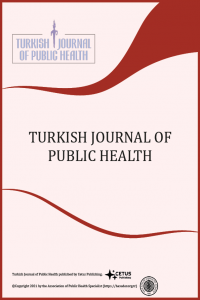Bir semt polikliniğine başvuran 0-6 yaş arası çocuğu olan ailelerin kurşun maruz kalım bilgilerinin incelenmesi
Kurşun zehirlenmesi, çocuk, kurşun maruziyeti
Investigation of lead exposure awareness of families with children aged 0-6 who applied to a district polyclinic
Lead poisoning, children, lead exposure,
___
- 1. Markowitz M. Lead Poisoning. In: Kliegman RM, Behrman RE, Jenson HB, and Stanton BF. editors. Nelson Textbook of Pediatrics. 18th ed. Philadelphia: Nelson Textbook of Pediatrics; Chine: Saunders, 2004. p. 2358-62.
- 2. Chisolm JJ. Jr: Lead Poisoning, in Principles and Practice of Pediatrics. Oski FA, sec ed, Lipincott com, 842-7, 1994.
- 3. Binns H.J., Campbell C., Brown M.J ve Centers for Disease Control and Prevention Advisory Committee on Childhood Lead Poisoning Prevention. Interpreting and Managing Blood Lead Levels of Less Than 10 μg/dL in Children and Reducing Childhood Exposure to Lead: Recommendations of the Centers for Disease Control and Prevention Advisory Committee on Childhood Lead Poisoning Prevention. Pediatrics 2007;120(5): e1285-e1298.
- 4. American Academy of Pediatrics Comittee on Environmental Health. Lead exposure in children:prevention, detection and management. Pediatrics 2005;116(4):1036-46.
- 5. Özmert E, Yurdakök K, Laleli Y. Ankara'da İlkokul Çocuklarında Kan Kurşun Düzeyi. Çocuk Sağlığı ve Hastalıkları Dergisi 2003;46:20-23.
- 6. Karaçayır N. Dilovası ve Kandıra’da Yaşayan İki-Altı Yaş Arasındaki Çocuklarda Kan Kurşun Düzeyi ve Anemi İlişkisi. Uzmanlık Tezi, Kocaeli Üniversitesi Tıp Fakültesi Çocuk Sağlığı ve Hastalıkları, Kocaeli, 2009.
- 7. Gilbert SG, Weiss B. A Rationale for Lowering the Blood Lead Action Level From 10 to 2 microg/dL. Neurotoxicology 2006;27:693–701.
- 8. Liu J, Liu X, Wang W, et.al. Blood Lead Concentrations and Children’s Behavioral and Emotional Problems: a Cohort Study. JAMA pediatrics 2014;168(8):737-745.
- 9. Brown MJ, McLaine P, Dixon S, & Simon, PA. Randomized, Community-Based Trial of Home Visiting to Reduce Blood Lead Levels in Children. Pediatrics 2006;117(1):147-153.
- 10. Haynes E, Lanphear BP, Tohn E, Farr N, Rhoads GG. The Effect of İnterior Lead Hazard Controls on Children's Blood Lead Concentrations: a Systematic Evaluation. Environ Health Perspect 2002;110:103-7.
- 11. Bozalan M. Oyuncaklardaki Kurşun Düzeyinin Atomik Absorbsiyon Spektrometre ile Tayini. Yüksek Lisans Tezi, Disiplinlerarası Adli Bilimler Anabilim Dalı Adli Kimya Ve Adli Toksikoloji Programı, Ankara, 2011.
- 12. Resmi Gazete, 17.05.2002 tarih/24758 sayı. Oyuncaklar Hakkında Yönetmelik. [online]. Available at: http://www.mevzuat. adalet.gov.tr/html/21042.html. Accessed January 12, 2017.
- 13. Healthy-stuff. [online]. Available at: http://www.ecocenter.org/healthystuff. Accessed January 12, 2017.
- 14. İritaş SB, Mergen G, Dip A, Ünal BM, Söylemezoğlu T, Ertan M. Survey of copper, lead and zinc levels in human liver. Toxicology Letters 2007;172:1– 240.
- 15. Muwakkit S, Nuwayhid I, Nabulsi M, et. al. Iron Deficiency in Young Lebanese children: Association with Elevated Blood Lead Levels. J Pediatr Hematol Oncol 2008; 30(5):382-386.
- Başlangıç: 2003
- Yayıncı: Halk Sağlığı Uzmanları Derneği
Tıp fakültelerinde ders ölüyor mu?
Duygu AKÇAY, Lütfiye Hilal ÖZCEBE
Çalışanlarının gözünden Türkiye'deki belediyelerde su yönetimi
Derya ÇAMUR, Hüseyin İLTER, Murat TOPBAŞ
Mersin ilindeki sağlık kurumlarında çalışan sağlığı ve güvenliği uygulamalarının değerlendirilmesi
Gülden ERSÖZ, Ali Koray KENZİMAN, Hakkı AKTAŞ, A. Öner KURT
Hekimlerin sosyal medya kullanımı ve etik
Bağırsak mikrobiyotası ve sağlık
Yaşlılarda yeti yitimi ve aleksitimi
